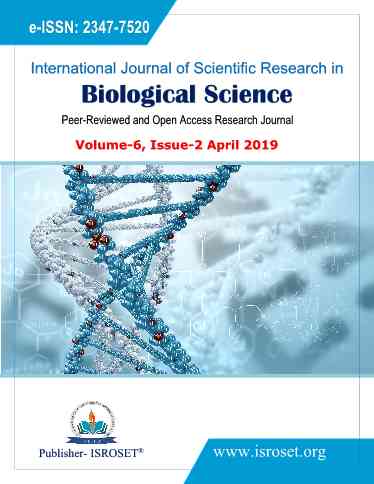Evaluation of Insecticidal and Antimicrobial Effect of Boerhavia diffusa
Keywords:
Biopesticide, Antimicrobial agent, Dysdercus cingulatusAbstract
Boerhavia diffusa, commonly known as ‘Punarnava’ in the Indian system of medicine is a perennial creeping herb found throughout the waste lands. The insecticidal activity of aqueous and acetone extracts of B. diffusa was tested against the pest insect Dysdercus cingulatus, commonly known as Red Cotton Bug. The plant extract exhibited ovicidal effect, nymphicidal effect, varying degree of moulting disruption, reduced fecundity rate along with prolonged mating period. Insecticidal property exhibited by this plant extract can be exploited in the field of Integrated Pest Management, so as to reduce the hazardous effects of chemical pesticides. The toxic principles present in the plant extract are actually secondary metabolites that are evolved as a protective measure against herbivorous animals. Antimicrobial activity of B. diffusa was also evaluated using gram negative bacteria, Pseudomonas aeruginosa and showed significant level of sensitivity to B. diffusa extracts. Thus it is evident that B. diffusa possess toxic principles having insecticidal as well as antimicrobial activity which can be employed in the field of agriculture and medicine respectively.
References
S. Ignacimuthu, “Insect Pest Control: Using Plant Resources”. Alpha Science International: 1.1, 2012.
D.E. Djeussi., J.A.K Noumedem., J.A Seukep, A.G. Fankam, I.K. Voukeng., S.B. Tanken., A.H.L. Nkuete, V. Kuete, “Antibacterial activity of selected edible plants extracts against multi drug- resistant Gram-negative bacteria”, BMC Complementary and Alternative Medicine, Vol.13, pp.164, 2013.
S. Singh, S. Singh, “Economic evaluation of pest management technologies for sustainable crop production in Punjab”, Agricultural Economics Research Review, Vol. 20, pp. 77-86, 2007.
Minfal, “Agricultural Statistics of Pakistan; Cash crops”, Government of Pakistan, Ministry of Food, Agricultural and Livest. (Econ. Wing), Islamabad: pp. 29-30, 2008.
Balcht, Aldona, Smith, Raymand, “Pseudomonas aeruginosa: Infections and Treatment”, Informa Health care, pp. 83-84, 1994.
K. Poole, “Efflux-mediated multiresistance in Gram-negative bacteria”, Clinical Microbiology and Infection, DOI: http://dx.doi.org/10.1111/j.1469-0691.2004.00763.x, 2004.
L.P. Awasthi, H.N. Verma, “Boerhavia diffusa – a wild herb with potent biological and antimicrobial properties”, Asian Agri-History, Vol. 10, pp. 55-68, 2006.
Babita Agarwal, Sunanda Das, Archana Pandey, “Boerhavia diffusa Linn: A Review on its Phytochemical and Pharmacological Profile”, Asian Journal of Applied Sciences, Vol. 4, Issue. 7, pp. 663-684, 2011.
D. Krishnaiah, A. Devi, Bono, R. Sarbatly, “Studies on phytochemical constituents of six Malaysian medicinal plants”, Journal of Medicinal Plants Research, Vol. 3, pp. 67-72, 2009.
Harborne J.B., “Phytochemical Methods- A guide to modern techniques of plant analysis”, Chapman & Hall publications, London, 3rd ed. 1998.
G. Evangelin, Chris Vaz., Junas Ekka., John Juliet, S.J. J. William, “Ovicidal, nymphicidal and juvenomimetic effect of Adathoda vasica extract on the red cotton stainer, Dysdercus cingulatus”. International Journal of Humanities, Arts, Medicinal and Sciences, Vol. 2, Issue.1, pp. 49-56, 2014.
P. Ramesh, A. Subramani, “Effect of antimicrobial activity of Eupatorium odoratum against clinical microbes”‖, International Journal of Scientific Research in Biological Sciences, Vol.5, Issue.5, pp.30-35,2018.
M.S. Hashim, K.S. Devi, “Insecticidal actions of the polyphenolic rich fractions from the stem bark of Streblus asper on Dysdercus cingulatus”, Fitoterapia, 744: pp. 670-676, 2003.
A. Asha, J. M. Rathi, D. Patric Raja, K. Sahayaraj, “Biocidal activity of two marine green algal extracts against third instar nymph of Dysdercus cingulatus (Fab.) (Hemiptera: Pyrrhocoridae)”, Journal of Biopesticides, Vol. 5 (Supplementary), pp. 129-134, 2012.
K. Sahayaraj, Mahesh Tomson, “Impact of two pathogenic fungal crude metabolites on mortality biology and enzymes of Dysdercus cingulatus” Journal of Biopesticides, Vol. 3 (1), (special issue), pp. 163-167, 2010.
P. Ranilalitha, M. Sukumaran, S. Raveendran, Kavitha Amirthanayagi, “Evalution of nymphicidal effect of two indigenous plant extracts on cotton pest, Dysdercus cingulatus”, International Journal of Pure and Applied Zoology, Vol. 3(1), pp. 24-30, 2015.
A. Asaraja, K. Sahayaraj, “Screening of insecticidal activity of brown macroalgal extracts against Dysdercus cingulatus (Fab.) (Hemiptera: Pyrrhocoridae)”, Journal of Biopesticides, Vol. 6(2), pp. 193-203, 2013.
S. J. Boeke, I. R. Baumgart, I. J. Van Loon, A. Dicke, M. Van Husin, D. K. Kossou, “Toxicity and repellency of African plants traditionally used for the protection of stored cowpea against Callosobruchus maculates”, Journal of Stored Products Research, Vol. 40, pp. 423-438, 2004.
Harshalata Sontakke, Irshad Baba, S. M. Jain, R. C. Saxena, Mahesh Ningwal, “Effect of extracts of Ailanthus excelsa on red cotton bug (Dysdercus cingulatus)”, IOSR Journal of Pharmacy and Biological Sciences, Vol. 6(5), pp. 44-45, 2013.
V. K. K. Prabhu, M. John, “Ovarian development in juvenilised adult Dysdercus cingulatus affected by some plant extracts”, DOI:10.llll/j.1570-7458.1975.tb00389. X, 2011.
Tanu Sharma, Ayesha Qamar, Absar Mustafe Khan, “Evaluation of neem (Azadirachta indica) extracts against the eggs and adults of Dysdercus cingulatus (Fab.)”, World Applied Sciences Journal, Vol. 9(4), pp. 398-402, 2010.
K. Sahayaraj, Y.M. Jeeva, “Nymphicidal and ovicidal efficacy of seaweed Sargassum tenerrium (J. Agardh) against Dysdercus cingulatus (Fab.) (Pyrrhocoridae)”, Chilean Journal of Agriculture Research, Vol. 72, Issue. l, pp.152–156, 2012.
A.R. Mahesh, Harish kumar, M.K. Rangamani, Raviraj Anand Devkar, “Detailed study on Boerhavia diffusa Plant for its Medicinal Importance - A Review”, Research Journal of Pharmaceutical Sciences, Vol. 3 Issue. l, pp. 28-36, 2012.
H.V. Girish, S. Sathish, “Antibacterial activity of important medicinal plants on human pathogenic bacteria -A comparative analysis”, World Applied Science, Vol. 5, pp. 267-271, 2008.
A.R. Mahesh, M. K. Rangamani, D. R. Harish kumar, “Enrichment of Flavonoids from the methanolic extracts of Boerhavia diffusa Roots by Partitioning technique”, Research Journal of Chemistry Sciences, Vol. 3, Issue.1, pp. 43-47, 2013.
Downloads
Published
How to Cite
Issue
Section
License

This work is licensed under a Creative Commons Attribution 4.0 International License.
Authors contributing to this journal agree to publish their articles under the Creative Commons Attribution 4.0 International License, allowing third parties to share their work (copy, distribute, transmit) and to adapt it, under the condition that the authors are given credit and that in the event of reuse or distribution, the terms of this license are made clear.







